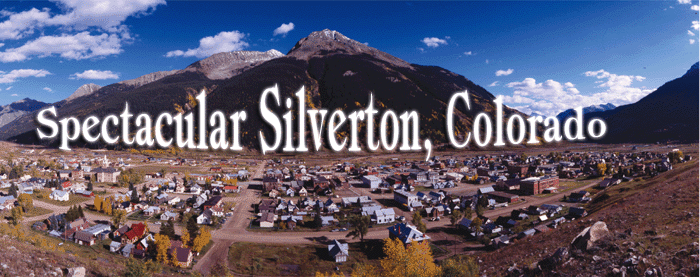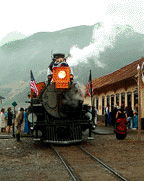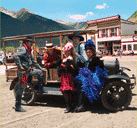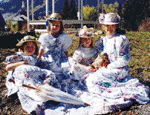| Silverton Magazine - Silverton, Colorado | ||
| Welcome to Silverton | Burke's Custom Tours for Photographers & Artists | Silverton Magazine Home Page |
 Anvil Mountain and Silverton from Above © Professor Shutterbug |
 All content © San Juan Publishing Group, Inc, All rights reserved
All content © San Juan Publishing Group, Inc, All rights reservedTHE SETTING IS SPECTACULAR, the town is unique; it';s living history preserved in spirit, lifestyle and architecture. Silverton sits on the roof of the nation, one of the last great remnants of the American West. It is just 250 miles from Denver, but twice that by rail — rails built by hand through he Rocky Mountains, an incredible feat accomplished against nearly-impossible odds of rugged terrain and hard weather. 
Today the town no longer connects to Denver by rail, but the tracks do lead south to Durango, home of the Durango & Silverton Narrow Gauge Railroad. With its authentic steam locomotives and strings of bright gold passenger cars, the train no longer carries supplies and workers to the mines that once sustained the community, but tourists, now the lifeblood of this old boom and bust town. Hardrock mining founded Silverton and kept it going for more than a century. Originally discovered by Charles Baker and his group looking for silver and gold here in the mid-1800s, the town was first called Baker's Park. It sits, a slightly sloped, flat meadow, in the bowl of an old volcanic caldera. Today the surrounding mountains top 14,000 feet, but eons ago, they poked their heads more than 30,000 feet into the brilliant blue sky. Baker and his group left, chased away by the Ute people for invading their native hunting grounds. But after the Civil War, survivors returned, freshly fortified, equally determined. After the Utes moved from the area following the signing of the Brunot Treaty, Silverton was established as a  mining camp, and later, a town. The main streets were named after early settlers: Greene, Reese, Snowden. A raucous red-light district was established on the east side of Greene, then later, a block east on "Notorious Blair Street." mining camp, and later, a town. The main streets were named after early settlers: Greene, Reese, Snowden. A raucous red-light district was established on the east side of Greene, then later, a block east on "Notorious Blair Street."
Because the town was never the victim of a major fire, as so many mining camps were, the buildings have been preserved, many of them with original furnishings, fixtures, stamped tin ceilings and polished, mirrored back bars. Because of its relative remoteness, Silverton has not (yet) suffered the fate of some of her neighbors and been developed to unaffordability, yuppified to death with trendy chain shops, pricey cafes and high dollar condos. It's still a friendly place to live and visit.  Much remains as it was. The mines are closed, but many reminders of them are still visible and visitable, in the mountains and in the
museum. The old bars and restaurants are still open for a drink or a meal. The ladies of the line are gone, but the bordellos are still there, spiffed up, winterized and made into comfortable hotels, shops and restaurants. Much remains as it was. The mines are closed, but many reminders of them are still visible and visitable, in the mountains and in the
museum. The old bars and restaurants are still open for a drink or a meal. The ladies of the line are gone, but the bordellos are still there, spiffed up, winterized and made into comfortable hotels, shops and restaurants.
All over Silverton, the pioneer spirit prevails, as descendants of the original families and determined newcomers welcome guests and proudly preserve their town of Silverton. Come, join us for a visit to a very special place. Top: Anvil Mountain and Silverton from Above © Professor Shutterbug. Far left: Fall (Carolyn Wilcox); July 4th (Debbie Foster); Snomobiles ( Jim Lokey) Bottom: City Hall, Wyman Hotel, and historic buildings, Greene Street. ©James Burke Right, top: Railfest, the 473 dressed in Bumblebee Paint scheme steams past the Silverton Depot. Kathryn Retzler Left center: The "Girls" on Blair Street. Kathryn Retzler. Right bottom: Picnic in the Park. Rogery Young. |
|
The Silverton Magazine. Copyright 2000-2010 Published by San Juan Publishing Group, Inc., Colorado No part of this publication may be reproduced in any means whatsoever without written authorization from SJPG. (plagerizers will be hung from the yardarm and fed to the mountain sharks!) Queries for re-print rights, email editor@sanjuanpub.com |
Copyright San Juan Publishing Group, Inc. Web design by Kathryn R Burke